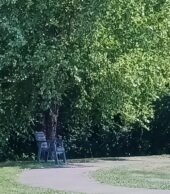Moderation and Rhythm: A Benedictine Help Against Social Isolation
She lives alone in her house. She stayed there after her husband died and requires oxygen support for 24 hours per day, carrying long tubes around her home that connect her mask to the oxygen tank. She could leave the house with the oxygen, but doesn’t want to because she is so filled with fear from watching the news.
He is 93 years old and still lives in his apartment. His friends have died and his children live in a different city. He goes weeks without talking with anyone because he feels there is no one to talk to.
What Is Social Isolation?
Each of these people is experiencing social isolation, a separation from community and human contact. Social isolation and loneliness are becoming a massive social issue that impacts people 65+ in urban, suburban and rural settings. Social isolation is defined as having little or no contact with other people.lasting for extended periods of time. Social isolation is different from loneliness, in that loneliness is a state of emotion that is felt by individuals who are not satisfied with their social connections. Therefore, a person who is experiencing social isolation does not always experience loneliness, especially in cases where social isolation is voluntary. In addition, loneliness can be temporary, whereas social isolation can last anywhere from a few weeks to years. Social isolation takes many forms, existing whenever a person of any age loses contact with family, friends and other partners in the social network.
What Are the Causes and Effects?
In the January/February (2017) issue of Social Work Today, researchers report that social isolation is a cause of poor health and early death. A study of social isolation and loneliness experienced by adults aged 52 and older found that both factors led to a higher risk of mortality (Steptoe, Shankar, Demakakos, & Wardle, 2013).
There are many causes of social isolation, such as: advanced age, medical issues, mobility issues, fear, broken relationships, death of friends and family, geography and accessibility. Essentially, social isolation is a loss of community and connection. Exacerbating these issues is the aging in place movement which is working to keep seniors in their homes. This movement is now beginning to address the need for life enrichment and social interaction. To address the causes of social isolation, we need to recognize the context and respond appropriately.
Models of Rhythm and Moderation
The issues of isolation and aloneness impact quality of life and keep individuals from becoming all that they can be. Yet the Hebrew/Christian Scriptures create a tension in our minds. In Genesis it is written, “it is not good for man to be alone” (2:18). But in Matthew 14.23, we read: “After Jesus had dismissed the crowds, he went up the mountain by himself to pray. When evening came, he was there alone.” If Jesus sets an example of being alone and being renewed, which of these are the way we should go?
The answer, frankly, is both. The rhythm of life leads one to times of being alone and times of being in community. The Rule of St. Benedict structures this for the monk. The monk needs time alone and needs time in community. This Benedictine model of rhythm and moderation is an example for healthy living.
For those in social isolation, however, the rhythm becomes broken. Those in social isolation are too alone.Those in social isolation become cut off from conversation, community and meaningful connection. How then does one support those in social isolation?
Again, Benedict helps us see a way of life. Monks are in isolation for prayer, but, they come together for meals and community prayer. The monk has other monks for connection, and, the monk has the abbot as companion and guide.
What We Can Do for One Another
But what about the isolated senior who is not in a monastic setting? This is where monastic life can offer insight as to what might be done.
- First, identify those who are socially isolated. Some may be isolated because they want to be, but those in Christian community recognize that this is not healthy and work to befriend the isolated senior.
- Then one can find ways in which to engage the senior. Find topics of interest for conversation. Engage in one on one connection and be prepared to even take the isolated senior for a drive or to a movie. It is the human connection that becomes so powerful.
Benedictine hospitality places emphasis upon the lost and the marginalized. Benedictine hospitality invites one to see Christ in the face of the other and to treat the other accordingly.
 Explore the basics of Benedictine Spirituality.
Explore the basics of Benedictine Spirituality.
Learn more about Steve Arnold and his upcoming events.






